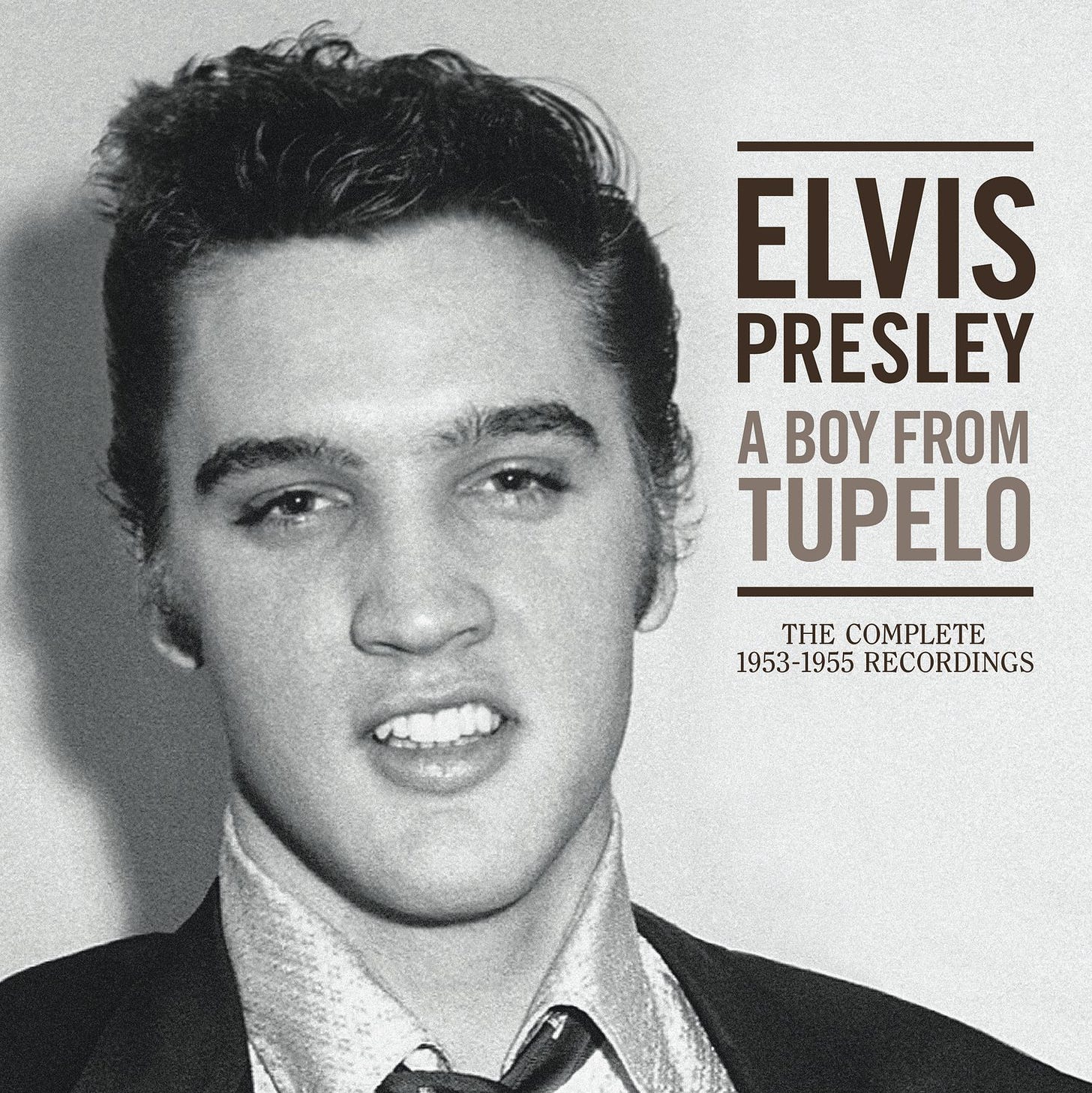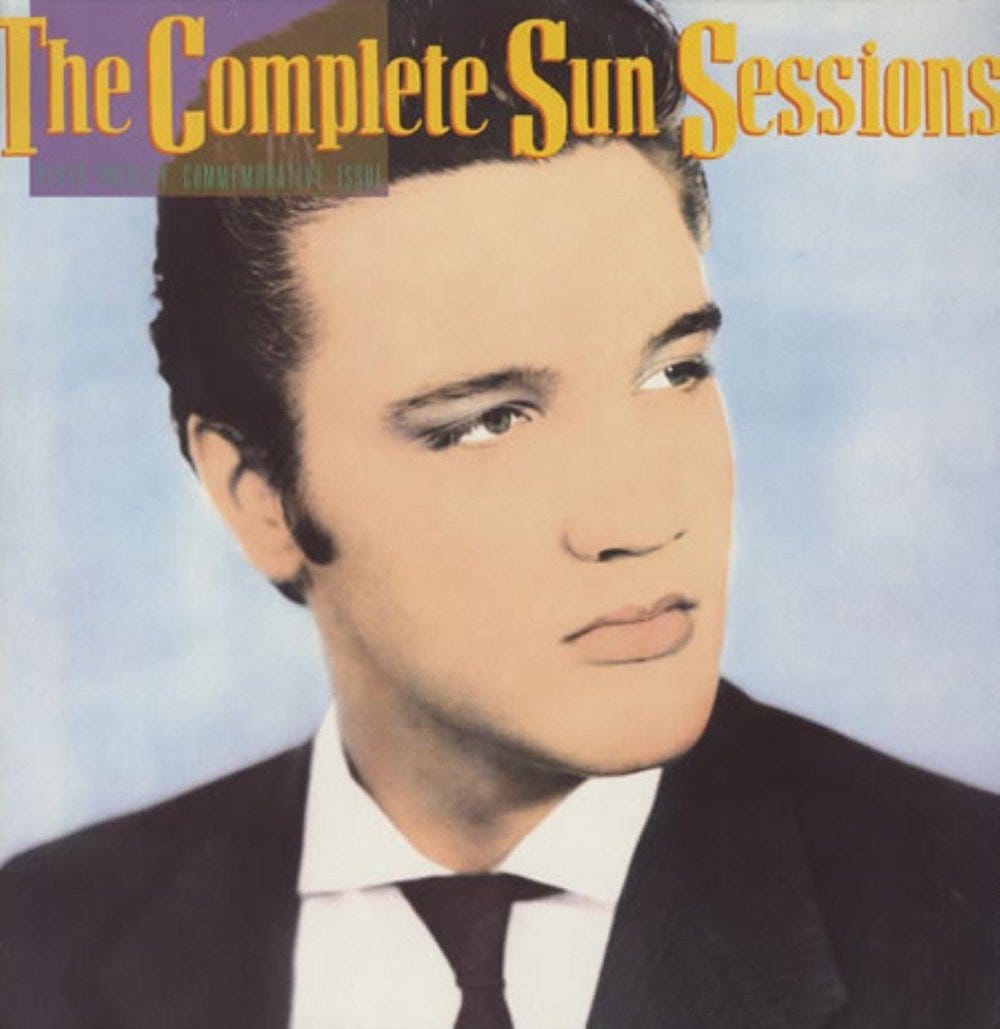Where Elvis MIGHT have taken music...
In August of 1954, a month into his career, he got "real gone"
The date was August 19, 1954, just four days before I turned one. According to the front page of the New York Times, the Democratic Presidential candidate of 1952, Adlai E. Stevenson stood at the Illinois State Fair in Springfield and called the Republican Party “divided, embittered and querulous.” The United States was soon going to withdraw four of six divisions from Korea. And the two inquiries into the conduct of Senator Joseph R. McCarthy “moved forward slowly” today.
Down in a tiny recording studio at 906 Union Avenue in Memphis, Tennessee, a young singer stood before a microphone, Bill Black next to him on a standup bass, guitarist Scotty Moore standing by, recording a Rodgers and Hart song from twenty years earlier. A song called “Blue Moon.”
“A Boy From Tupelo” - All of Elvis’ recordings from 1953-1955 including “Blue Moon.”
It was just a few harried weeks after he burst onto the Memphis scene with “That’s All Right, Mama” his free-wheeling remake of an Arthur “Big Boy” Crudup blues number that lit up switchboards all over the city when Dewey Phillips spun the acetate Sun Studios owner Sam Phillips had brought over to WHBQ for Dewey’s 9-to-midnight shift. They didn’t even have a B-side yet, that would happen in a few days. Sam thought the song was so different, so unique, that he just had to get it on the air and he knew Dewey would play it for him. And he was right.
As Peter Guralnick explained in his wonderful Presley biography “Last Train To Memphis”: “The response was instantaneous,” he wrote. “Forty-seven phone calls, it was said, came in right away, along with fourteen telegrams? – he played the record seven times in a row, eleven times, seven times over the course of the program.”
But they couldn’t release a one-sided single so they worked up a rockabilly version of bluegrass master Bill Monroe’s “Blue Moon of Kentucky” a few days later and slapped it on the B-side. Something clicked. “Hey, that’s a pop song, nearly ‘bout,” you can hear an excited Sam Phillips say after they’d recorded it. They were going places.
In a time when music seemed to be relegated to strict, never-to-be-violated categories, Phillips said the hell with all that. He had Presley, a poor white kid from Memphis (Tupelo, Mississippi, originally) cover a blues song from a black artist, then had him take a classic bluegrass number and make it, as he said, “a pop song.”
On July 19, Sam Phillips released Sun 209 as a single, which sold about 20,000 copies in the Memphis area, a hit. But that success brought with it another problem. What next? A recording artist has to keep those hits coming, right?
Since Elvis didn’t write songs – no singers did in those days - what was next, where was he going to go? On August 19, back inside Sun Studio, maybe a warm summer evening, Presley decided to pick a famous popular song from 20 years earlier, a song recorded by Billy Eckstine, Mel Torme and others.
“ Let’s try “Blue Moon” with just me and a bass line,” he must have said. It was ballsy, daring, even. This 19-year-old kid who’d only recorded, what two or three songs so far, decides to re-interpret a classic? A song that everybody was familiar - and comfortable – with already? And he was going to take it somewhere else.
About 13 seconds in, you hear the quiet thump of the bass. Then it stops. Resumes about the 40-second mark. Then that velvety, magical, tender Presley voice eases the words out, almost sliding the sounds into the open microphone. The tape is running.
“Blue moon…you saw me standing alone. Without a dream in my heart. Without a love of my own. Blue moon, you knew what I was there for. You hear me saying a prayer for someone I really could care for.”
Then a swooping, beautiful, soaring falsetto… “without a dream of my own.”
More falsetto…the bass thumping along.. “without a love of my own.” and that voice, that lilting, rising lifts into the higher register…it’s astonishing. And once it’s finished, in the background, you hear someone, maybe Bill Black say “That’s good.”
It is. They track it as nine takes, about 13 minutes of the bass and Presley’s softly emotional, tender voice, leaping up into falsetto to try to wring every possible bit of emotion out of the song. Why, just the way he sings “alone” is haunting, as if he really feels it. Aided by the classic Sun Studio slapback, it’s brilliant, haunting, so completely natural, unschooled and directly from the heart, the only way, at least in this early days, Elvis knew how to sing.
The song absolutely blew me away on Disc 2 of “A Boy From Tupelo” the three-record set of all the Sun Studio recordings from 1953 to 1955. Not that Disc 1, the original complete Sun Sessions didn’t. I’d heard all those songs, before, including the original master of “Blue Moon” which is haunting and beautiful.
But I hadn’t heard the outtakes, the whole birth of his version of the song or imagined where Presley and that remarkable voice and soaring falsetto, where that instinctual musical genius MIGHT have gone, if that side of his talent had been encouraged, developed, nurtured. Considering how far he went here, where might he have gone next?
Though they were always announced as “RCA recording artist Elvis Presley” nobody really, seriously bought the “artist” part of that. At that time, producers selected the material. They’d find a song, then look for a voice to sing it. That was what brought Elvis to Sun Studios to begin with.
Elvis had gone in to record a couple of songs, supposedly for his mother months earlier. Marion Keisker who worked at Sun, listened in, found something unusual in his voice, wrote his name down.
Later, when Phillips was trying to find someone to cut a song he liked, either he or Keisker suggested Presley, history offers different interpretations. While they didn’t particularly like his version of that song, they did like his off-the-cuff version of “That’s All Right, Mama” cut it, and the world changed.
The original Sun Sessions, Elvis in the studio at 906 Union Avenue, starting out.
Years later, as Phillips told Guralnick about recording Elvis, he spoke about where Elvis and Memphis was at the time. “…the quiet nights, people living on plantations, never out of debt, hoping to eat, lights up the river - that’s what they used to call Memphis. That was where it all came together, And Elvis Presley may not have been able to verbalize all that - but he damn sure wasn’t dumb, and he damn sure was intuitive, and he damn sure had an appreciation for the total spirituality of the human existence, even if he never would have thought of the term. That was what he cared about.”
That intuitiveness, those musical instincts, if only Elvis had really been able to explore those the way he did on “Blue Moon.”
But the times for that weren’t right; TV people were so freaked out about the revolutionary Presley shaking his hips, they’d only film him from the waist up, how could he have thought about going further? And Phillips was simply trying to keep Sun afloat, he ended up selling off Presley’s contract to RCA for $35,000, a huge sum at the time and something Phillips insisted until his dying day he didn’t regret. He still had Johnny Cash, Carl Perkins, Jerry Lee Lewis, Charlie Rich…
And Elvis himself, he wanted to be a movie star as much as anything. Not that he didn’t love music. But he hit the world so hard and so fast, there didn’t ever seem to be time for him to sit down and think about what HE really wanted to do, to truly follow where those musical instincts might have taken him. And us.
On one of the Sun Records cuts he recorded in December called “Milkcow Blues Boogie” the song starts quietly. Then, dramatically, Presley stops the band. “Hold it fellas. That don’t move me. Let’s get real, real gone for a change.”
He did get real real gone back on August 19. As gone as he’d ever get.
The released version of “Blue Moon” from August 19, 1954. To me, the outtakes are better.






He was not only gigantic and came at the right time, but he opened the door for so many others!!